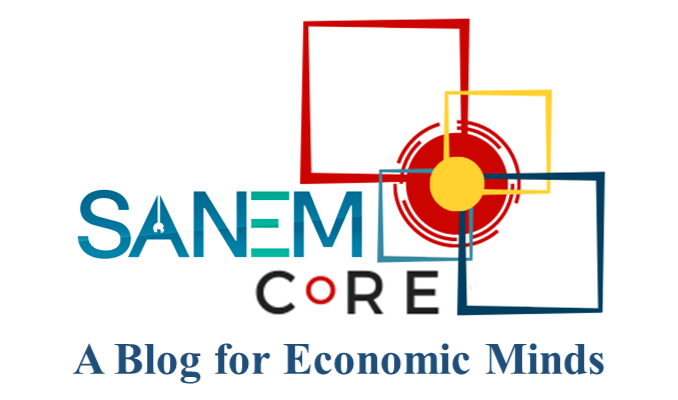BRICS is an acronym for Brazil, Russia, India, China, and South Africa. The term was first used as BRIC in 2001 by Jim O’Neill, an economist at Goldman Sachs, as South Africa joined the BRICS later in 2010. By 2050, according to Goldman Sachs, this bloc would control a majority of the world economy. This assertion was made mostly because for many years, China, India, Brazil, Russia, and South Africa were ranked among the fastest-growing and emerging market economies. Low labour costs, favourable demographics, and an abundance of natural resources are argued to be this bloc’s key comparative advantages.
The BRICS bloc created the hope to serve the common interests of the global south – the developing countries and the emerging market economies. In recent times the world economy has witnessed an unprecedented growth of emerging market economies and developing countries with their share in global GDP rising from less than 40% in 1990 to almost 60% in 2022. Also, between 1990 and 2022, the combined share of developing countries in global export trade reached close to 40% from just about 20%. Trade between developing countries increased by an average annual rate of 10% since 2000, hitting $5.3 trillion in 2021. During the same period, world trade grew at a slower 5.5%. Although impressive growth performance has characterized many developing countries, it is the rise of such economies of BRICS has widely been recognized as the defining features of the advanced south, paving the way for a world economy with an increasingly multi-polar character. At present, BRICS accounts for around 32% of global GDP, 41% of the global population, 16% of global trade, and 26% of the earth’s land area.
The era of the post-2008 global economic crisis marks the relative decline of the West, the end of the post-Cold War unipolar moment, and the rise of China and other major economies, all of which are challenging the current world order. The world is now fragmented due to escalated protectionism, explicit and implicit trade wars, and the emergence of regional mega blocs like RCEP, CPTPP, TTIP, etc. While the current centres of gravity for global politics and economics are Asia and the Western Pacific, geopolitics is now taking new turns due to the growing gap between the distribution of economic and military powers which is driving further division. These trends are likely to shape the future of the world order. The BRICS bloc is seen as the centre of gravity of the emerging new world order.
However, despite the much-created hype, there are doubts about whether BRICS, as a bloc, is capable of creating a new world order. In my view, BRICS can’t become a powerful economic and trade bloc in the near future for a variety of reasons.
First, BRICS is an investment cooperation, not a trade forum. One notable achievement of the BRICS bloc is that in 2014, at the 6th BRICS summit, the BRICS states signed the Agreement on the New Development Bank (NDB). The NDB is a multilateral development bank with the aim to support public or private projects through loans, guarantees, equity participation and other financial instruments. However, without comprehensive agreements in the areas of trade in goods and services, trade facilitation, intellectual property rights, and non-tariff measures, mere investment cooperation would not be meaningful. The prospect of such comprehensive trade agreements among BRICS countries seems bleak. Also, there are allegations that BRICS countries impose various restrictions on investment from each other. In July 2023, India rejected Chinese automaker BYD’s US$1 billion investment proposal to build electric cars and batteries in India in partnership with a local company. Allegedly, security concerns with respect to Chinese investments in India have been flagged by the Indian authorities. Certainly, such concerns are not helpful for BRICS to emerge even as a powerful platform for investment cooperation.
Second, the bilateral political relations among some of the BRICS countries are not smooth and favourable. Also, the bilateral political anonymity between the USA and China, and between the USA and Russia affect the internal political relations within BRICS countries. On top of these, the bilateral political relation between China and India (the two largest economies in BRICS) is tense and, in recent years, dwindling. In contrast, currently, India and the USA maintain close relations, common interests, and collaboration on issues such as counterterrorism and countering Chinese influence in the Indo-Pacific region. India is a member of the QUAD (the Quadrilateral Security Dialogue, a strategic security dialogue between Australia, India, Japan and the USA) which was allegedly formed to contain the rising influence of China in the Indo-Pacific region. While India was part of the initial RCEP (Regional Comprehensive Economic Partnership) negotiations; allegedly, due to the growing political tension between India and China and strong domestic resistance in India for not opening up its market to China, India pulled herself out from the RCEP negotiation in 2019. The border conflicts between these two countries are on the rise. India is highly concerned about the growing Chinese presence in its South Asian neighbouring countries. Therefore, if the two most powerful economies in BRICS don’t cooperate effectively with each other, the prospect of BRICS emerging as a powerful entity will remain bleak.
Third, the much-hyped BRICS currency is not feasible. As long as the economic differences between the member countries remain considerable, and an inherently strong mood of non-cooperation continues between India and China, the common currency is unrealistic. However, bilateral currency swaps (as it is happening on some scales between China and Russia, and between India and Russia) may continue to reduce the dependence on US Dollar.
Fourth, the recent inclusion of the six new members (Argentina, Ethiopia, Saudi Arabia, Iran, UAE and Egypt) in BRICS doesn’t provide a clear and solid roadmap for the BRICS to consolidate power and redefine global governance into a “multipolar” world order that prioritizes the voices of the global South. The inclusion of Saudi Arabia, Iran, UAE and Egypt seems very Middle East-centric which has more oil-centric geo-economic, geostrategic and geopolitical implications rather than representing the interests of the global South. BRICS to emerge as the voices of the global South needs to work out carefully its expansion plan.
What are Bangladesh’s stakes in BRICS? Bangladesh has strong economic aspirations to become part of a forum like BRICS. Both China and India are Bangladesh’s major trading partners, growing sources of external funding and prospective investments. However, a few non-economic factors are becoming increasingly important for Bangladesh to get the rightful entry in such forums. These factors include the evolving nature and challenges in domestic politics, and challenges in maintaining the balance of bilateral relations with China, India, and the USA. While Bangladesh needs effective and enlarged trade and investment cooperation with all these three countries, increasingly it is becoming difficult to maintain a reasonable balance due to the pressures coming from these three countries out of their geostrategy and geopolitics, and for Bangladesh to handle these pressures in the contexts of conflicting domestic politics, weak institutions and governance.
Finally, when it comes to enlarging trade, the graduation from the LDC status by 2026 will bring new challenges for Bangladesh. Among the BRICS nations, China and India are Bangladesh’s two largest import sources. Bangladesh, as an LDC, gets duty-free facilities for the export of all products to India, except for 25 liquor and tobacco goods. In China, Bangladesh’s exports receive duty-free treatment in 98% of tariff lines. In the post-LDC-graduation era, unless Bangladesh signs FTAs with India and China, Bangladesh will lose its preference in these markets. Bangladesh hasn’t signed any bilateral FTA so far. The only success is the PTA with Bhutan for some products. With this very limited experience, no doubt, Bangladesh needs to do proper homework while negotiating FTAs with India and China in the coming days. Even if Bangladesh is able to join BRICS in the future, how effectively the country manages its trade, investment, and strategic relationships with India and China will also be a critical factor for realizing its own benefits from BRICS.
The article was first published in The Daily Star, on 4 September 2023.


RECENT COMMENTS